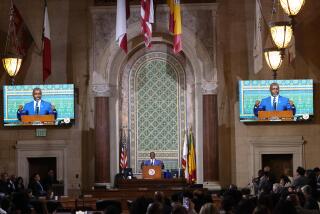Will the Tattered Bradley Coalition Fade Into History?
- Share via
Will the departure of Tom Bradley, Los Angeles’ first black mayor, weaken the political clout of the African-American community and of liberals in general?
Or, since the mayor has been such an invisible figure lately, is it possible that his retirement won’t make much difference?
These are questions that cannot be answered until the new mayor takes over. But one thing is sure: The June 8 mayoral election will be traumatic to a generation that remembers an earlier Bradley, the reformer who led an alliance of African-Americans and white liberals that shifted Los Angeles politics leftward from its conservative roots.
A large number of those white liberals were Jews. In fact, the movement was powered by a black-Jewish alliance dedicated to civil rights and social and economic programs for L.A.’s long-ignored minorities.
At the center of the coalition was Bradley, who stood alone in the superheated politics of the ‘60s and early ‘70s because he had the rare ability to reassure and comfort all races, all the city’s contesting groups.
*
The story of the liberal alliance and its impact on Los Angeles government is told in an invaluable new book, “Politics in Black and White: Race and Power in Los Angeles” by Prof. Raphael J. Sonenshein of Cal State Fullerton, published this month by the Princeton University Press.
As the ‘50s ended, Sonenshein recalled, liberals and minorities were, for the most part, excluded from power in a city that had been shaped by conservative white businessmen. This had important social consequences. “City Hall was insulated from changes in U.S. society and could pursue a small town conservatism of fiscal stringency, strong support for the forces of order and reluctance to participate in federal social programs,” Sonenshein wrote.
Blacks and Jews were among the groups excluded from political power. But they both understood that politics and government were needed to improve their city and their lives. Government, and the politicians who ran it, could protect them from hostile forces in society.
The alliance was born in the middle-class neighborhoods of southwestern L.A. in a process so basic and down to earth that it seems a lifetime away from the hyped, advertising-dominated politics of today. The story of how it happened is one of the most interesting parts of Sonenshein’s book.
Just as it is now, the Los Angeles of the ‘60s was a segregated city, although middle-class blacks and Jews lived in fairly close proximity in neighborhoods west of Crenshaw Boulevard.
In addition, African-American and Jewish activists had been working together since the late ‘50s in a reform organization called the California Democratic Council. The CDC consisted of neighborhood clubs joined in a powerful statewide political organization.
The Bradleys were one of the first black families to move into the southwestern neighborhood of Leimert Park, where they were met with some hostility. Bradley was a police lieutenant, a quiet man whose demeanor masked his driving ambition.
Through his job as a police community relations officer, he met many Jewish merchants and civic leaders. In the ‘60s, Bradley was a political activist and soon was president of the biracial Leimert Park Democratic Club, which had many Jewish members.
Maury Weiner, who became Bradley’s top political aide, gave Sonenshein a glimpse of Bradley in those days. Weiner was working for an early multiracial political campaign when “a very tall black man walks in and offers to walk precincts. Everyone else in the office knew him. At that point, he was fully involved in Democratic clubs. People told me: ‘That’s Tom Bradley.’ ”
Bradley was also a well-known and respected person in the working-class black neighborhoods east of Crenshaw. He brought everyone together, from east and west of Crenshaw, for his election to the City Council in 1963.
In 1969, Bradley ran for mayor and lost to Mayor Sam Yorty. Four years later, Bradley was elected. For the liberals, the two campaigns were crusades. Activists believed that Bradley was an heir to the legacy of the assassinated Martin Luther King Jr. and Robert Kennedy, who had been killed in this city.
Bradley and his liberal allies brought new social programs into poor areas; vastly increased the number of women, ethnic minorities and white liberals on city commissions; installed affirmative action programs in city government, and attempted to impose civilian control on the Los Angeles Police Department.
This helped blacks move into the middle class. Sonenshein found that the percentage of whites on the municipal work force dropped from 64.1% in 1973 to 46% in 1991. The number of African-Americans, Latinos, Asian-Americans and women in managerial positions increased greatly.
*
In this election, we move on to a new chapter of municipal history. It is one that seems more complicated than those earlier days when Bradley captured the hopes of a city that could not imagine today’s many ethnic groups and extremes of wealth and poverty.
The liberal coalition is alive only in the memory of its aging members. Its heart and soul, the coalition of African-American and Jewish activists who banded together in the days of Martin Luther King Jr. and Robert Kennedy, is going or is gone, as is the leader who held them together--Tom Bradley.
It will be the challenge for Los Angeles’ next mayor to form a new coalition capable of confronting today’s much more difficult times.
More to Read
Sign up for Essential California
The most important California stories and recommendations in your inbox every morning.
You may occasionally receive promotional content from the Los Angeles Times.













